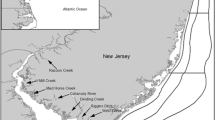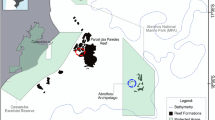Abstract
Combining gut content analysis and sampling of ambient zooplankton, we examine departures from random feeding in a planktivorous coral reef fish and explore the effects of apparent non-random feeding behavior on the relative contribution of oceanic versus reef-associated zooplankton to fish diet. The planktivorous damselfish Dascyllus flavicaudus appears to exhibit strong positive electivity for oceanic copepods including Candacia spp. and copepods from the families Oncaeidae and Corycaeidae and consistent negative electivity for cyclopoid copepods (Oithonidae). In total, prey taxa categorized as oceanic in origin contributed 10–76 % of total zooplankton biomass in fish guts. The summed contribution of oceanic prey taxa to fish diet was significantly higher than expected under a model of random feeding based on the availability of oceanic versus reef-associated prey as sampled by zooplankton net tows. The feeding behavior of D. flavicaudus appears to be visibility-selective rather than or in addition to size-selective, as electivity across prey taxa could not be explained by differences in prey size alone.







Similar content being viewed by others
References
Alldredge AL (1972) Abandoned larvacean houses: a unique food source in the pelagic environment. Science 177:885–887. doi:10.1126/science.177.4052.885
Alldredge AL, King JM (2009) Near-surface enrichment of zooplankton over a shallow back reef: implications for coral reef food webs. Coral Reefs 28:895–908. doi:10.1007/s00338-009-0534-4
Almeda R, Calbet A, Alcaraz M et al (2010) Effects of temperature and food concentration on the survival, development and growth rates of naupliar stages of Oithona davisae (Copepoda, Cyclopoida). Mar Ecol Prog Ser 410:97–109. doi:10.3354/meps08625
Baguley JG, Hyde LJ, Montagna PA (2004) A semi-automated digital microphotographic approach to measure meiofaunal biomass. Limnol Oceanogr Methods 2:181–190
Baker J, Polovina J, Howell E (2007) Effect of variable oceanic productivity on the survival of an upper trophic predator, the Hawaiian monk seal Monachus schauinslandi. Mar Ecol Prog Ser 346:277–283. doi:10.3354/meps06968
Chong-Seng KM, Cole AJ, Pratchett MS, Willis BL (2010) Selective feeding by coral reef fishes on coral lesions associated with brown band and black band disease. Coral Reefs 30:473–481. doi:10.1007/s00338-010-0707-1
Clements KD, Raubenheimer D, Choat JH (2009) Nutritional ecology of marine herbivorous fishes: ten years on. Funct Ecol 23:79–92. doi:10.1111/j.1365-2435.2008.01524.x
Cleveland A, Verde EA, Lee RW (2010) Nutritional exchange in a tropical tripartite symbiosis: direct evidence for the transfer of nutrients from anemonefish to host anemone and zooxanthellae. Mar Biol 158:589–602. doi:10.1007/s00227-010-1583-5
Cole AJ, Pratchett MS, Jones GP (2008) Diversity and functional importance of coral-feeding fishes on tropical coral reefs. Fish Fish 9:286–307. doi:10.1111/j.1467-2979.2008.00290.x
DeMartini EE, Friedlander AM, Sandin SA, Sala E (2008) Differences in fish-assemblage structure between fished and unfished atolls in the northern Line Islands, central Pacific. Mar Ecol Prog Ser 365:199–215. doi:10.3354/meps07501
Depczynski M, Fulton CJ, Marnane MJ, Bellwood DR (2007) Life history patterns shape energy allocation among fishes on coral reefs. Oecologia 153:111–120. doi:10.1007/s00442-007-0714-2
Drenner RW, Strickler JR, O’Brien WJ (1978) Capture probability: the role of zooplankter escape in the selective feeding of planktivorus fish. J Fish Res Board Canada 35:1370–1373
Emery AR (1973) Comparative ecology and functional oseteology of fourteen species of damselfish (Pisces: Pomacentridae) at Alligator Reef, Florida Keys. Bull Mar Sci 23:649–770
Frederich B, Pilet A, Parmentier E, Vandewalle P (2008) Comparative trophic morphology in eight species of damselfishes (Pomacentridae). J Morphol 269:175–188. doi:10.1002/jmor
Glynn PW (1973) Ecology of a Caribbean coral reef. The Porites reef-flat biotope: part II. Plankton community with evidence for depletion. Mar Biol 22:1–21. doi:10.1007/BF00388905
Gorsky G, Ohman MD, Picheral M et al (2010) Digital zooplankton image analysis using the ZooScan integrated system. J Plankton Res 32:285–303. doi:10.1093/plankt/fbp124
Grice G (1963) A revision of the genus Candacia (Copepoda: Calanoida) with an annotated list of the species and a key for their identification. Zool Meded 38:171–194
Hamner WM, Jones MS, Carleton JH et al (1988) Zooplankton, planktivorous fish, and water currents on a windward reef face: Great Barrier Reef, Australia. Bull Mar Sci 42:459–479
Hamner W, Colin P, Hamner P (2007) Export-import dynamics of zooplankton on a coral reef in Palau. Mar Ecol Prog Ser 334:83–92. doi:10.3354/meps334083
Hessen DO (1985) Selective zooplankton predation by pre-adult roach (Rutilus rutilus): the size-selective hypothesis versus the visibility-selective hypothesis. Hydrobiologia 124:73–79
Hobson ES (1991) Trophic relationships of fishes specialized to feed on zooplankters above coral reefs. In: Sale P (ed) The ecology of fishes on coral reefs. Academic Press, San Diego, CA, pp 69–93
Holzman R, Genin A (2005) Mechanisms of selectivity in a nocturnal fish: a lack of active prey choice. Oecologia 146:329–336. doi:10.1007/s00442-005-0205-2
Hwang J, Turner J (1995) Behaviour of cyclopoid, harpacticoid, and calanoid copepods from coastal waters of Taiwan. Mar Ecol 16:207–216
Johnson AS, Sebens KP (1993) Consequences of a flattened morphology: effects of flow on feeding rates of the scleractinian coral Meandrina meandrites. Mar Ecol Prog Ser 99:99–114
Kingsford MJ, MacDiarmid AB (1988) Interrelations between planktivorous reef fish and zooplankton in temperate waters. Mar Ecol Prog Ser 48:103–117
Kiørboe T, Andersen A, Langlois VJ, Jakobsen HH (2010) Unsteady motion: escape jumps in planktonic copepods, their kinematics and energetics. J R Soc Interface 7:1591–1602. doi:10.1098/rsif.2010.0176
Lazzaro X (1987) A review of planktivorous fishes—their evolution, feeding, behaviors, selectivities and impacts. Hydrobiologia 146:97–167
Lee RF, Hirota J (1973) Wax esters in tropical zooplankton and nekton and the geographical distribution of wax esters in marine copepods. Limnol Oceanogr 18:227–239
Lee RF, Hagen W, Kattner G (2006) Lipid storage in marine zooplankton. Mar Ecol Prog Ser 307:273–306
Lefevre M (1986) Variations spatio-temporelles du peuplement zooplanctonique du lagon de l’isle de Moorea (Archipel de La Societe, Polyneise Francaise). l’Universite Pierre et Marie Curie, Paris
Llopiz J, Cowen R (2009) Variability in the trophic role of coral reef fish larvae in the oceanic plankton. Mar Ecol Prog Ser 381:259–272. doi:10.3354/meps07957
Logerwell EA, Ohman MD (1999) Egg-brooding, body size and predation risk in planktonic marine copepods. Oecologia 121:426–431. doi:10.1007/s004420050948
Manly BFJ, McDonald LL, Thomas DL et al (2002) Resource selection by animals: statistical design and analysis for field studies, 2nd edn. Springer, Berlin
Nadon MO, Baum JK, Williams ID et al (2012) Re-creating missing population baselines for Pacific reef sharks. Conserv Biol 26:493–503. doi:10.1111/j.1523-1739.2012.01835.x
Norris JE, Parrish JD (1988) Predator-prey relationships among fishes in pristine coral reef communities. In: Proceedings of the 6th international coral reef symposium, vol 2, Australia, pp 107–113
O’Neil JM (1998) The colonial cyanobacterium Trichodesmium as a physical and nutritional substrate for the harpacticoid copepod Macrosetella gracilis. J Plankton Res 20:43–59. doi:10.1093/plankt/20.1.43
Odum AJ, Odum EP (1955) Trophic structure and productivity of a windward coral reef community on Eniwitok Atoll. Ecol Monogr 25:291–320
Paffenhöfer GA (1993) On the ecology of marine cyclopoid copepods (Crustacea, Copepoda). J Plankton Res 15:37–55
Pastorok RA (1981) Prey vulnerability and size selection by Chaoborus larvae. Ecology 62:1311–1324
Pratchett M, Gust N, Goby G, Klanten SO (2001) Consumption of coral propagules represents a signicant trophic link between corals and reef fish. Coral Reefs 20:13–17
Renon J (1989) Le zooplancton des milieux reifo-lagonaires de Polynesie. l'Université d'Orléans, Orléans, France
Rivers TJ, Morin JG (2012) The relative cost of using luminescence for sex and defense: light budgets in cypridinid ostracods. J Exp Biol 215:2860–2868. doi:10.1242/jeb.072017
Robertson D (1982) Fish feces as fish food on a Pacific coral reef. Mar Ecol Prog Ser 7:253–265. doi:10.3354/meps007253
Sampey A, McKinnon AD, Meekan MG, McCormick MI (2007) Glimpse into guts: overview of the feeding of larvae of tropical shorefishes. Mar Ecol Prog Ser 339:243–257. doi:10.3354/meps339243
Sargent MC, Austin TS (1954) Biologic economy of coral reefs. Bikini and nearby atolls. Part 2. Oceanography (biologic). U.S. Geological Survey Professional Paper 260-B, pp 293–300
Satapoomin S (1999) Carbon content of some common tropical Andaman Sea copepods. J Plankton Res 21:2117–2123. doi:10.1093/plankt/21.11.2117
Schmitz OJ, Hawlena D, Trussell GC (2010) Predator control of ecosystem nutrient dynamics. Ecol Lett 13:1199–1209. doi:10.1111/j.1461-0248.2010.01511.x
Sebens KP, Vandersall KS, Savina LA, Graham KR (1996) Zooplankton capture by two scleractinian corals, Madracis mirabilis and Montastrea cavernosa, in a field enclosure. Mar Biol 127:303–317
Shimomura O, Johnson FH, Masugi T (1969) Cypridina bioluminescence: light-emitting oxyluciferin–luciferase complex. Science 164(80):1299–1300
Stier AC, Hanson KM, Holbrook SJ et al (2014) Predation and landscape characteristics independantly affect reef fish community organization. Ecology 95:1294–1307
Utne-Palm AC (1999) The effect of prey mobility, prey contrast, turbidity and spectral composition on the reaction distance of Gobiusculus flavescens to its planktonic prey. J Fish Biol 54:1244–1258. doi:10.1111/j.1095-8649.1999.tb02052.x
Westneat MW, Resing JM (1988) Predation on coral spawn by planktivorous fish. Coral Reefs 7:89–92
Williams DM, Hatcher AI (1983) Structure of fish communities on outer slopes of inshore, mid-shelf and outer shelf reefs of the Great Barrier Reef. Mar Ecol Prog Ser 10:239–250. doi:10.3354/meps010239
Williams ID, Baum JK, Heenan A et al (2015) Human, oceanographic and habitat drivers of central and western Pacific coral reef fish assemblages. PLoS One 10:e0120516. doi:10.1371/journal.pone.0120516
Wyatt ASJ, Lowe RJ, Humphries S, Waite AM (2013) Particulate nutrient fluxes over a fringing coral reef: source-sink dynamics inferred from carbon to nitrogen ratios and stable isotopes. Limnol Oceanogr 58:409–427. doi:10.4319/lo.2013.58.1.0409
Yúfera M, Parra G, Santiago R, Carrascosa M (1999) Growth, carbon, nitrogen and caloric content of Solea senegalensis (Pisces: Soleidae) from egg fertilization to metamorphosis. Mar Biol 134:43–49
Zaret TM, Kerfoot C (1975) Fish predation on Bosmina longirostris: body-size selection versus visibility selection. Ecology 56:232–237
Acknowledgments
We thank M. D. Ohman for providing access to ZooScan equipment and for guidance on the design and analysis of the study. We thank A. Stier, L. Bentley, D. Combosch, W. Boudreau, K. Willis, and L. Sala for their contributions to collections, imaging and image analysis. Comments from M. D. Ohman, L. Levin, L. Aluwihare, and I. Abramson improved the manuscript and analyses. This research was supported by awards from the National Science Foundation through the Moorea Coral Reef LTER program and NSF award OCE-0927448 to JJL, a Northeastern University Three Seas Teaching Fellowship to KMH, and an NSF REU fellowship to ELS via the California Current Ecosystem LTER. Fish collection was approved by French Polynesian research permits and the UCSD Institutional Animal Care and Use Committee (Protocol # S06369).
Author information
Authors and Affiliations
Corresponding author
Additional information
Responsible Editor: K. D. Clements.
Reviewed by Undisclosed experts.
Rights and permissions
About this article
Cite this article
Hanson, K.M., Schnarr, E.L. & Leichter, J.J. Non-random feeding enhances the contribution of oceanic zooplankton to the diet of the planktivorous coral reef fish Dascyllus flavicaudus . Mar Biol 163, 77 (2016). https://doi.org/10.1007/s00227-016-2849-3
Received:
Accepted:
Published:
DOI: https://doi.org/10.1007/s00227-016-2849-3




